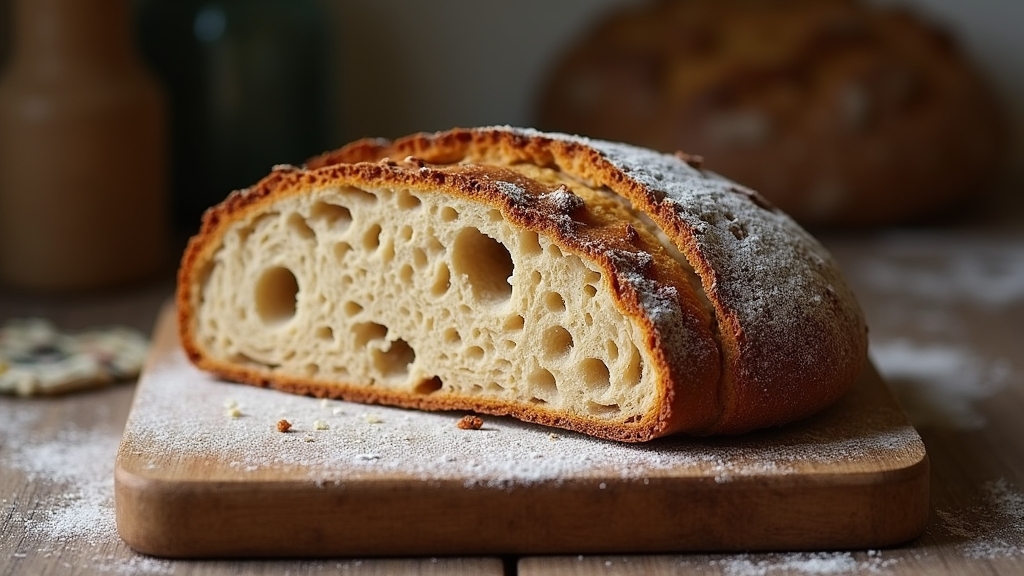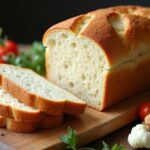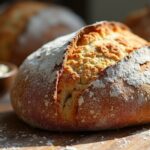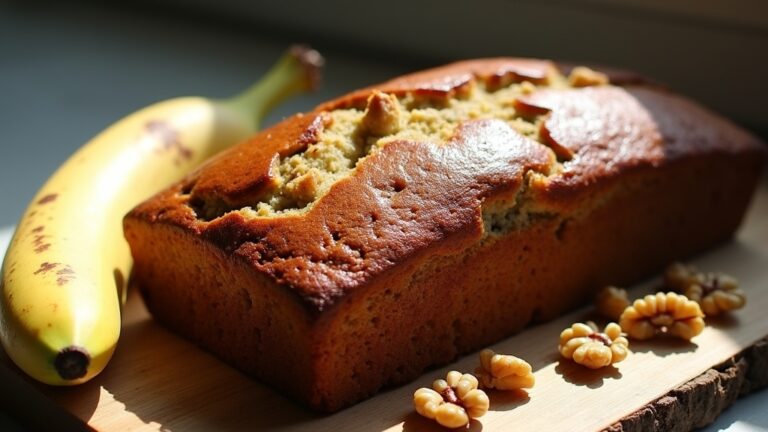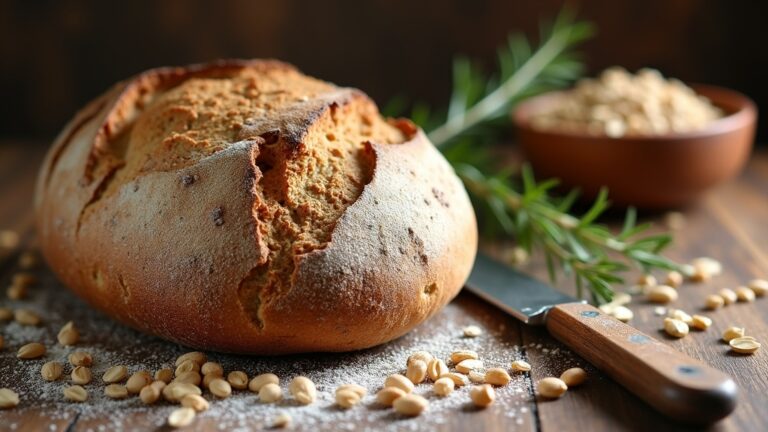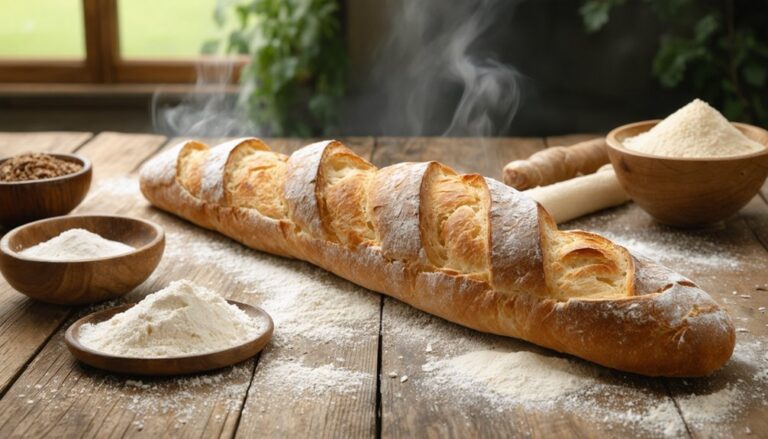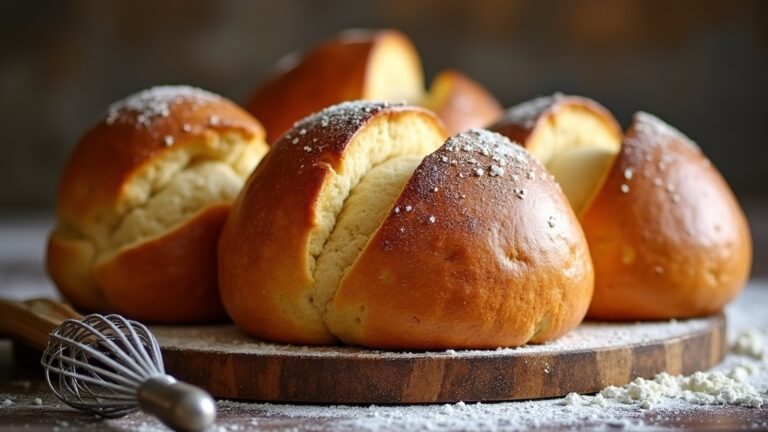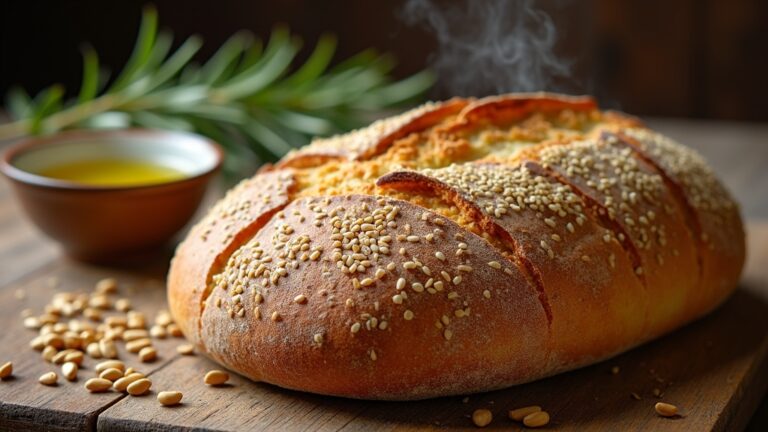Sourdough Rye Bread Recipe
To start your sourdough rye bread, mix 1 cup of active sourdough starter with 1 ½ cups lukewarm water. Then, blend in 2 cups rye flour, 1-2 cups bread flour, 1 ½ teaspoons salt, and optionally, 1 tablespoon sugar. After kneading until smooth, let it rise in a warm spot. Bake at 400°F after shaping and proofing in a floured banneton. The crusty, flavorful loaf you’ll pull from the oven might just inspire your next baking adventure.
Contents
History
While many believe that sourdough bread finds its origins exclusively in San Francisco, its history actually winds much further back, cradling its roots deeply in ancient civilizations. The magic of sourdough begins with the fermentation process, a brilliant dance between bacteria and yeast thriving on the starches of ancient grains. To understand this, imagine harnessing the robust flavors and nutritional benefits of grains like einkorn or emmer, cultivated thousands of years ago. These grains, mixed with water, create a lively culture that breathes life into your dough. It’s not merely mixing and baking; it’s reviving a tradition, an art form. Embrace these ancestral methods to innovate your baking process, infusing age-old wisdom into every loaf you craft.
Recipe
Sourdough rye bread is a flavorful and hearty bread that is perfect for those who appreciate a denser, more textured loaf. The tangy flavor of sourdough pairs beautifully with the robust taste of rye, making it an excellent choice for sandwiches or simply to enjoy with a smear of butter. This recipe utilizes a sourdough starter, which you should prepare in advance to guarantee it’s active and ready to help your bread rise. The process of making sourdough rye bread is deeply rewarding, as it involves traditional baking techniques that have been used for generations.
The key to successful sourdough rye bread lies in the fermentation process, which not only helps the bread rise but also develops its unique flavor and texture. This recipe is perfect for bakers who have some experience with sourdough, as working with rye flour can be slightly more challenging due to its lower gluten content. However, even beginners with patience and a passion for artisan bread can achieve excellent results. Let’s get started on baking this delightful loaf.
Unlock the secrets of sourdough rye bread and master its unique fermentation process for a truly artisanal loaf.
Ingredients:
- 1 cup active sourdough starter
- 2 cups rye flour
- 1-2 cups bread flour (adjust based on dough consistency)
- 1 ½ teaspoons salt
- 1 tablespoon sugar (optional, for a slightly sweeter bread)
- 1 ½ cups lukewarm water
- Cornmeal or flour for dusting
In a large mixing bowl, combine the sourdough starter, rye flour, 1 cup of bread flour, salt, sugar, and lukewarm water. Mix until all the ingredients are well incorporated. Gradually add more bread flour as needed until the dough is slightly sticky but manageable. Knead the dough on a floured surface for about 10 minutes until it becomes elastic. Place the dough in a lightly oiled bowl, cover it with a damp cloth, and let it rise in a warm place for about 4-6 hours, or until it has doubled in size. After the first rise, shape the dough into a loaf, sprinkle some cornmeal or flour on a baking sheet, place the shaped dough on it, and let it rise for another 1-2 hours.
Baking sourdough rye bread requires attention to detail, especially during the fermentation and proofing stages. Make sure your sourdough starter is very active before you begin your bread. The dough should feel alive and elastic under your hands as you knead it. When baking, make certain that your oven is properly preheated to 400°F (200°C), and consider using a steam pan in the oven to create a crusty exterior. Bake the bread for about 30-35 minutes, or until the crust is dark brown and the loaf sounds hollow when tapped. Allow the bread to cool on a wire rack before slicing to let the structure set properly. Enjoy your homemade sourdough rye bread with a variety of toppings or as the base of a delicious sandwich.
Cooking Steps
Now, let’s get our hands into the heart of making our sourdough rye bread, where every step is essential for that perfect loaf. First, you’ll mix your active starter with water until they’re thoroughly combined—this is the foundation of your dough’s flavor and texture. Then, we’ll add the rye flour and salt, and I’ll show you how to knead this mixture into a smooth, elastic dough that’s just waiting to rise and transform.
Step 1. Mix Starter and Water
First, let’s tackle the heart of our sourdough rye bread by mixing the starter with water. Achieving the right starter hydration is essential for that perfect loaf. Begin by measuring the water temperature; ideally, it should be around 78°F to activate the yeast without shocking it. Pour the water gradually into your starter, stirring consistently to distribute the yeast evenly. This gentle incorporation wakes up the starter, ensuring it’s lively and ready for the next steps. Be meticulous yet gentle, as this foundation sets the tone for the entire baking process. You’re not just mixing ingredients; you’re setting the stage for the intricate dance of flavors and textures that define artisan sourdough rye bread.
Step 2. Add Flour and Salt
Once you’ve got your starter and water mixed, it’s time to introduce the rye flour and salt. Rye flour, rich in fiber and distinctly flavorful, transforms your bread’s texture and taste. Opt for a blend of whole grain and white rye flours for a balanced, nuanced loaf. Now, let’s talk salt—don’t skimp here! Besides enhancing flavor, salt regulates yeast activity and strengthens the gluten network in your dough. Sprinkle it evenly to guarantee a well-seasoned crumb.
Mix these dry ingredients gently into your liquid base until they’re just combined. You’re not just making bread; you’re crafting a masterpiece. Each ingredient plays a pivotal role in the final, hearty, and delicious outcome.
Step 3. Knead Dough Thoroughly
Begin kneading the dough with vigor, pressing and folding it back onto itself to develop the gluten strands critical for a chewy crumb. Immerse yourself in this process, embracing the tactile experience. Your hands are your best tools here. Employ various kneading techniques to enhance the dough’s elasticity. Try the “slap and fold” method, which involves lifting the dough, slamming it against the countertop, and folding it over. This isn’t just about mixing; it’s about invigorating the dough, aligning those gluten strands through rhythmic motion.
Feel the transformation under your palms. The dough should evolve from sticky and shaggy to smooth and elastic, a reflection of your skill and the magic of proper kneading. This is where passion meets perfection.
Step 4. Allow Dough to Rise
After your dedicated kneading session, the dough’s next step is to rise, revealing flavors and textures that are uniquely sourdough. This is where the magic happens! It’s vital to maintain an ideal dough temperature, ideally around 75°F, which is the sweet spot for yeast activity. This warmth awakens the yeast, coaxing it into action, and transforming your dough into a bubbly, airy masterpiece.
Cover your dough snugly with a damp cloth and let it rest in a cozy corner of your kitchen. Patience is key; don’t rush this process. You’ll see the volume increase considerably, a thrilling indicator of properly harnessed yeast power. This rise is not just a wait; it’s an essential evolution in your sourdough’s journey.
Step 5. Shape and Proof Dough
As your dough doubles in size, it’s time to shape and proof, the steps that turn it into a beautiful loaf. I’ll guide you through innovative dough shaping and proofing techniques that guarantee a perfect sourdough rye every time. Begin by gently flouring your surface and turning out the dough. Shape it with purpose, folding the sides under to create tension on the surface. This isn’t just about aesthetics; it’s about crafting a structure that captures gases and enhances flavor.
For proofing, place your shaped loaf into a well-floured banneton. The goal here is a slow, cool rise. I recommend refrigerating it overnight. This extended proofing period develops depth, tanginess, and a delightful crumb. Excited? Let’s bake something amazing.
Nutritional Guide
While exploring the art of baking sourdough rye bread, it’s crucial to understand its nutritional benefits. This bread isn’t just about tantalizing your taste buds; it’s a powerhouse of health perks. Let’s explore the ingredient breakdown to grasp the full spectrum of its health benefits.
| Ingredient | Benefit | Why It Matters |
|---|---|---|
| Rye Flour | High Fiber | Supports digestion |
| Sourdough | Probiotics | Boosts gut health |
| Water | Hydration | Aids metabolic processes |
Each component of sourdough rye bread contributes uniquely to your well-being. Rye flour, rich in fiber, aids in digestion and prolongs satiety. The natural fermentation of sourdough introduces beneficial probiotics, enhancing gut health. Embracing this bread means nurturing your body with every slice.
Final Thoughts
If you’re ready to embrace a healthier lifestyle, baking sourdough rye bread is a fantastic step forward. I’ve shared my journey and secrets to help you master this art. Now, incorporate my baking tips to refine your technique. Experiment with flavor variations—think caraway for a traditional twist or orange zest for a modern kick. Each batch is a chance to innovate, discovering unique tastes and textures that delight your palate and nourish your body. Baking is both a science and an art, requiring precision and passion. So, trust your instincts, adjust as necessary, and always aim for that perfect crust and tender crumb. Here’s to your baking adventure—may it be as fulfilling as it is delicious!
Frequently Asked Questions
Can Sourdough Rye Bread Help Improve Digestion?
Yes, it can! The probiotic benefits and high fiber content in this bread aid digestion considerably. You’ll experience enhanced gut health and smoother digestion by incorporating it into your diet.
Is Sourdough Rye Bread Suitable for a Low-Carb Diet?
I wouldn’t recommend sourdough rye bread for a low-carb diet. Instead, explore innovative low carb alternatives that retain rye bread benefits. Immerse yourself in authentic techniques to create these options while maintaining a passionate approach.
How Do I Store Sourdough Rye Bread to Extend Its Freshness?
To keep your bread as fresh as a morning dew, wrap it in a cotton cloth and store in a cool, dark place. This traditional method guarantees ideal freshness and extends bread storage life.
Can I Use a Bread Machine to Make Sourdough Rye Bread?
Yes, you can use a bread machine for sourdough rye! Explore innovative sourdough variations and follow specific bread machine tips to guarantee authentic, delicious results. Embrace this technique to revolutionize your baking experience!
What Are the Best Toppings for Sourdough Rye Bread?
Who doesn’t love a good topping? For sourdough rye, I’d suggest smoked salmon and cream cheese. The rich flavors pair beautifully. Don’t forget a sprinkle of capers for that extra zing! What’s your favorite combination?
Conclusion
I’ve guided you through the ancient art of sourdough rye, contrasting our fast-paced digital age with the timeless, slow-baking process. Embrace this journey; let the rich, tangy slices reconnect you to a craft as old as civilization itself. Remember, each loaf you bake carries forward a legacy of patience and transformation. So, cherish the crackle of the crust, the dance of flavors. Share your bread, share the story—sourdough rye isn’t just food; it’s a slice of history.
